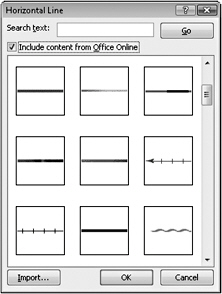Inserting Graphical Horizontal Lines
In some situations, you’ll want only a divider line, not a complete border, to set off sections or special elements in a document. For example, if you’re creating a report, you might want to mark the end of one section and the beginning of the next by adding a horizontal line. In those cases, you can use the Inside Horizontal Border option in the Border list to insert only a top or bottom partial border, or you can insert a graphical horizontal line. Applying the Inside Horizontal Border setting and creating partial borders are discussed earlier in this chapter, in “Creating Partial Borders” on page 285. The particulars of working with graphical horizontal lines-lines that are images-are covered in the next couple of sections.
Adding a Graphical Horizontal Line
Word provides a collection of graphical horizontal lines that you can insert in documents. To add a graphical horizontal line to a document, follow these steps.
-
Place the insertion point where you want to add the line.
-
Display the Borders And Shading dialog box and select the Borders or Page Border tab.
-
Click the Horizontal Line button in the lower-left corner of the dialog box to display the Horizontal Line dialog box, shown in Figure 10–18.
-
Scroll through the selections and click a line style to add the line.

Figure 10–18: The Horizontal Line dialog box displays predesigned graphical lines that you can insert in your document.
After you place a horizontal line in a document, you can select, copy, paste, resize, move, and color it as you would other graphical items. Furthermore, you can insert additional instances of the line by choosing the Horizontal Line option from the Border button’s menu.
Formatting a Graphical Horizontal Line
When you insert a graphical horizontal line by using the Horizontal Line dialog box, you’re not committed to using the image as is. You can adjust several of the line’s properties, including its width, height, and color. Specifically, you can perform either of the following actions.
-
Resize and position a line manually To resize and position a graphical line manually, click the line and then drag the line’s selection handles to resize it, or drag the selected line to move the image.
-
Adjust a graphical line’s properties To change a graphical line’s width, height, color, alignment, brightness, and contrast, as well as to crop some graphical lines, use the Format Horizontal Line dialog box (shown in Figure 10–19). To open the Format Horizontal Line dialog box, right-click a graphical line and then choose Format Horizontal Line (or simply double-click the line).

Figure 10–19: The Format Horizontal Line dialog box enables you to customize a graphical line’s appearance and placement by configuring the line’s settings.
Importing a Custom Line
If you create your own graphical lines in Word or another program (such as Microsoft Paint or Microsoft Office PowerPoint 2007), you can add the customized line files to your Horizontal Line gallery. To add a custom line to your Horizontal Line gallery so that it’s available in the Horizontal Line dialog box, follow these steps.
-
In the graphics program you’re using to create the line, save the file in a common graphics file format such as JPG, BMP, TIF, or WMF.
-
In Word, display the Borders And Shading dialog box.
-
On the Borders or Page Border tab, click Horizontal Line.
-
In the Horizontal Line dialog box, click Import to open the Add Clips To Organizer dialog box.
-
Navigate to the file you want to use, click it, and then click Add. The line is added to the gallery and remains selected.
-
Click OK to add the clip to your document. The Horizontal Line dialog box closes, and the line is placed at the insertion point in your document.
EAN: 2147483647
Pages: 299